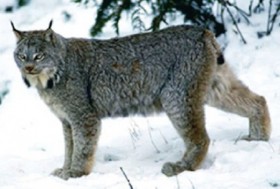The Canada lynx is a forest cat of northern latitudes and high mountains. While Maine has long been a home to the Lynx, experts believe relatively few have inhabited the state until recently. It is listed as “threatened” under the U.S. Endangered Species Act.
According to the Maine Department of Inland Fisheries and Wildlife, about 600 to 1,200 adult lynx live in northern and western areas of the state.
It is similar in size to the bobcat, but appears larger because of its long legs. It has unique, long (over one inch) black tufts of fur on the ears and a short, black-tipped tail. (Bobcats have small tufts, and 3-4 black bars on the tail. The tip is black on top, white underneath.)
The Canada lynx winter coat is light gray and faintly spotted; the summer coat is shorter and reddish-brown. Lynx have unusually large, densely haired feet to help travel over snow. Adult males average about 33.5 inches long and weigh 26 pounds. Females are about 32 inches long and average 19 pounds.
Lynx mate in March and, in Maine, produce an average of three kittens. Their dens in Maine consist of a bed under thick young fir or elevated downed logs. The female raises the kittens. Young leave the den art in late June or early July.
Lynx are highly specialized to hunt snowshoe hare, which comprise over 75 percent of their diet. When hares are abundant, lynx may eat one or two a day. In the summer, the diet is more varied and may include grouse, small mammals, and squirrels. In winter, dead animals may supplement the diet.
Family groups (mother and kittens) hunt together to increase efficiency. Males are solitary for most of the year except the breeding season. Size of the home range varies with snowshoe hare density, habitat, and season. In Maine, home ranges are about 18 square miles.
Additional resources
Hoving, Christopher L., et al. “Canada lLynx Lynx canadensis habitat and forest succession in northern Maine, USA.” http://www.maine.gov/ifw/wildlife/pdfs/hoving%20et%20al.pdf [University of Maine, Raymond H. Fogler Library, Special Collections]
Kobalenko, Jerry. Forest Cats of North America. Willowdale, Ont. Firefly Books. 1997.
Maine Department of Inland Fisheries and Wildlife. “Canada Lynx (Lynx canadensis).” http://www.maine.gov/ifw/wildlife/species/endangered_species/canada_lynx/ (accessed January 14, 2012)
Robinson, Laura. Ecological Relationships Among Partial Harvesting, Vegetation, Snowshoe Hares, and Canada Lynx in Maine. 2006. (Thesis (M.S.) in Wildlife Ecology–University of Maine, 2006.) [University of Maine, Raymond H. Fogler Library, Special Collections]
Scott, Shonene A. Spatio-temporal Dynamics of Snowshoe Hare Density and Relationships to Canada Lynx Occurrence in Northern Maine. 2009. (Thesis (M.S.) in Wildlife Ecology–University of Maine, 2009) [University of Maine, Raymond H. Fogler Library, Special Collections]



Hi, I’m doing research of an old family story about a black Canadian Lynx being shot and turned into a Maine university to determine what it was. It was said to be an all black Canadian lynx and was stuffed and donated to a Maine museum. The town it was shot in was Wellington ,Maine. The woman who told the story was in fact born in 1925 and said she was a teenager at the time. So the date this happened would have to be 1938 and up. Any information on this would be very appreciated.
Thank you Tom B